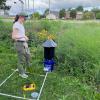What is the annual timeline for the BanDrosky and DeWind awards?
The proposal period for both awards is open for approximately two months each year, from the beginning of November to the end of December. Proposals are usually due in early January. The award committees will then assess proposals and assign scores, which are used to arrive at a final decision. Decisions for the DeWind Award are made no later than March 31 and BanDrosky Awards are made by April 15,with awards usually paid out in June. All applicants will be notified of the results by email. For this year's timeline, please see the DeWind Award and BanDrosky Award pages.
How many awards are granted each year?
We typically award two grants each year for both awards. Award amounts are determined annually. In 2026 there are two awards of $5,000 each and two ‘honorable mention’ awards that do not receive financial compensation but will be included in the list of winners on the award websites
Who is eligible for the awards?
The DeWind Awards are given to students who are engaged in research leading to a university degree related to Lepidoptera conservation and who intend to continue to work in this field. The BanDrosky Awards are given to students engaged in research as part of a university degree related to invertebrate conservation and who intend to continue to work in this field.
What types of projects are eligible for the awards?
Proposed research for the DeWind Award should have a clear connection to Lepidoptera conservation.
Proposed research for the BanDrosky Award should have a clear connection to an invertebrate species or group known to be in decline, including (but not limited to) native bees, butterflies and moths, fireflies, tiger beetles, freshwater and terrestrial mollusks (including freshwater mussels), and other freshwater dependent aquatic invertebrates. Awards will be given to applications whose proposed research highlights species known to be in need of conservation, is directly relevant to the species’ conservation, and is scientifically rigorous.
In addition, proposed projects (or the portion of the project that would use awardfunding) must be completed within one year of receiving funds.
I am an undergraduate student. Am I eligible for these awards?
Yes. Applicants may be graduate or undergraduate students; however, please note that all awards are judged to the same standards regardless of the degree.
I am an international student based outside of the US. Can I apply for these awards?
Yes. Applications from countries outside the United States will be considered but must be written in English. International applicant work cannot involve work in the United States, unless you are studying at a U.S. university.
I am an international student studying at a U.S. university. Can I use the funds for work in the US?
Yes, since you are based in the U.S. as a student, work can involve the U.S.
Can the award be used to pay for stipends of interns helping with my research efforts, or overhead or administrative fees?
Awards are paid as a qualified scholarship, which may be used for qualified or non-qualified education expenses as defined by the IRS. This allows recipients to avoid taxation on the grant if used for qualified education expenses. Recipients may use the award for other purposes that support them in completing their education or research. Note that awards are made payable only to the recipient of the scholarship, and cannot be paid to an institution or other third party.
Can I include figures or graphics in my proposal? Is there a limit to the number of types of figures and graphics?
Yes, you may include graphs or other figures in the proposal body. There is no limit to how many you may include, but note that the entire proposal body (including graphs and figures) should be no longer than 2 pages, and you will want to be sure to include all the other pertinent information mentioned in the application instructions.
My proposal was not selected this year. Can I get feedback on how to improve or strengthen it for next year?
Given the number of applications received each year, the awardcommittees do not usually provide feedback on individual proposals.
I was just notified by email that I will be receiving an award! What can I expect next?
Congratulations! You will be sent an official award letter and some paperwork to sign and send back to Xerces, including a Memorandum of Agreement (MOA) and a W-9 form (if applicable). BanDrosky Award payments of $5,000 will be paid in a single installment.
DeWind Awards of $5,000 will be paid in two installments: a minimum of $4,000 a few weeks after we have received the MOA signed by the recipient, and the remainder of the award ($1,000) upon receipt by Xerces of a final report or status update on your project (which is due no later than June 30, approximately one year after release of funds). Failure to meet the report deadline will result in forfeiture of the final $1,000.
I am an Award recipient and have published the results of my work in a scientific journal. Is Xerces interested in seeing the paper?
Absolutely! Please send your manuscript and/or a link to it to bandrosky@xerces.org or dewind@xerces.org. We will add it to our list of publications.




